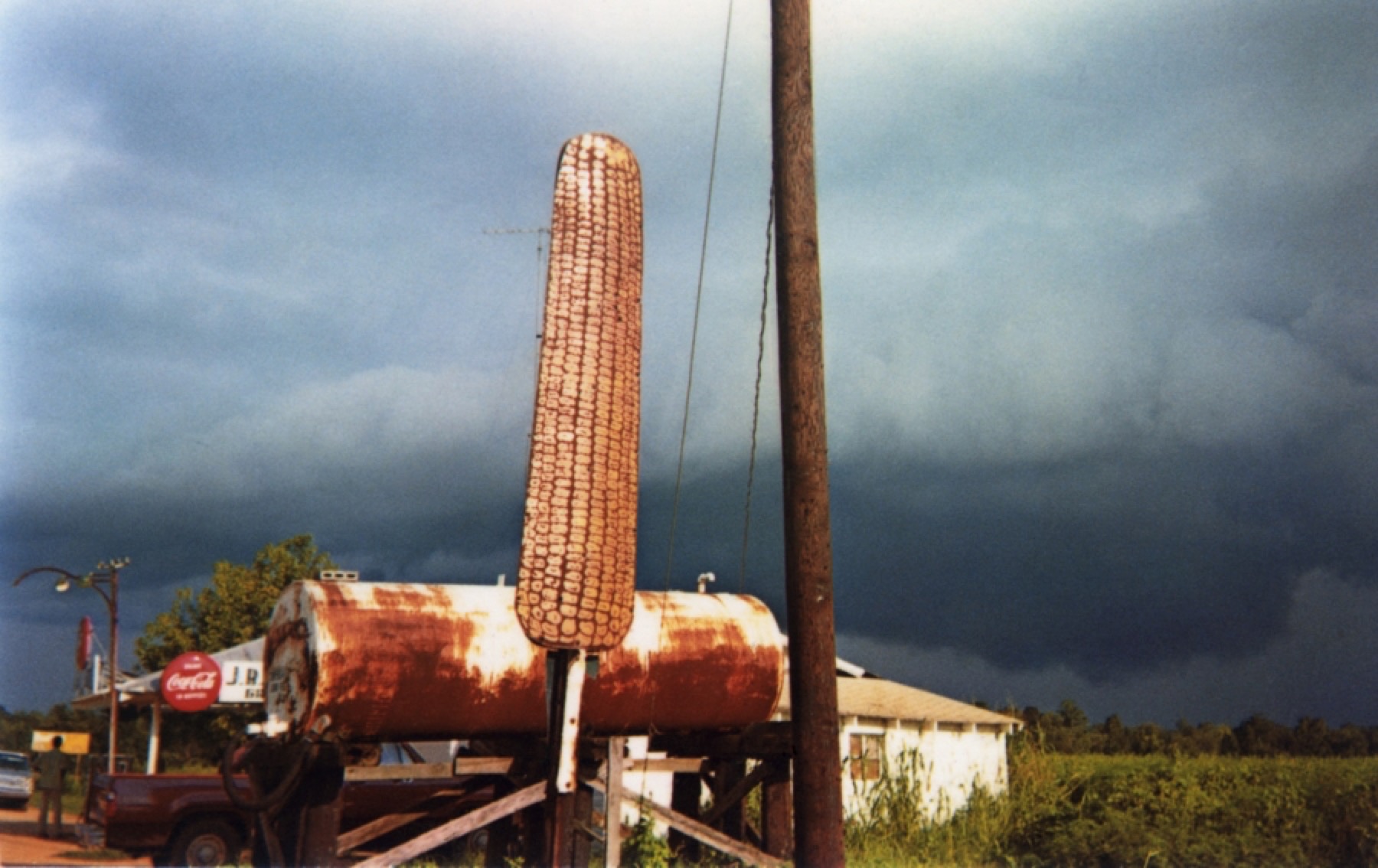
Corn Sign with Storm Cloud, near Greensboro, Alabama, 1977. All images © William Christenberry, courtesy Pace/MacGill Gallery, New York and Hemphill Fine Arts, Washington, DC
WHAT I LEARNED FROM WILLIAM CHRISTENBERRY
By Rebecca Gayle Howell
A Prayer at the Turn of the Year
If between 1997 and 2008 you found yourself in Lexington (I assume you know I mean Kentucky), that Parisian arrondissement once celebrated as the entry to the American frontier, the nineteenth-century white gentleman’s last stop for intellectual or religious stimulation—not to mention the other and unmentionable kinds—that still, despite its interstate buffer of box stores and chain restaurants, hums with culture salons and cocktails and sidewalk cafés; if you found yourself there on a Friday afternoon, in a Main Street or High Street rush, you might have seen the twenty-four-, twenty-eight-, thirty-two-year-old me at lunch with my first mentor, the experimental art photographer and writer James Baker Hall, a man forty years my senior, who every week for a decade and more tried his damnedest to teach me what I would need to know, after he was gone, to live the life to which I felt called, the life of the artist.
You would have thought we were on a date, for the intensity with which we spoke. Many no doubt did. We were not. Our lunches, to us, were a serious business, our own private salon, where over prosciutto and cheese we would argue and agree about the terms of an artist’s life, what sacrifices are involved, what pleasures, what disciplines. To train the eye, the ear to receive a radio wave not heard or seen by most, may not require madness, exactly, but certainly a deliberate, life-defining allegiance to the Unknown, i.e. faith.
From the beginning, it was photography that we talked most about. Jim would arrive exactly at 1 P.M. carrying monographs, a stack six or seven deep in the crook of his left arm, his right coming around me in a dear embrace. He was short, wiry, a tennis player until his lungs collapsed, an athlete before he gave his own life over to art at the age of eighteen. Atget, Modotti, Weston, Stieglitz, Avedon, Karsh, Brassaï, Bresson, Ulmann. He would hand the books to me with no explanation, no bias of who was who and why and what the world already thought of the work. He told me only to put paper clips on the pages holding photographs that “found something in me.” I’d spend days peering into the images like they were tiny time machines, perfect portals to what makes us each eternal—what I only know to call light—returning the next Friday with pages marked, eager to talk about what I was looking at and what I might have not yet looked at. Across the years I saw few women photographers, and no documentarians, but Jim’s affections were contagious and, without I think either of us knowing it, what would become my ear for poetry was being trained by looking at the lyric world of twentieth-century pictures.
No documentarians, save William Christenberry, that is. Although Jim’s own reputation is yet to bloom, in his devoted life he was often the intimate of historic artists; he had come up into manhood with Wendell Berry, worked for Minor White in Aperture’s early days, and was close to Ralph Eugene Meatyard. So it was not a point of extravagant conversation, Jim having known Christenberry; maybe it was their acquaintance that had warranted the exception of his inclusion in my teaching, I don’t know. Jim had little use for documentary work, which he saw as less than art, Art. Documentary was too straight, too literal, it risked (I can still hear the judgment in his tone): agenda. But that late-eighties Aperture monograph, Southern Photographs, made it into one of those Friday piles, and its clear-eyed presence among the hazy-lensed pictorialists and righteous modernists changed my relationship to Art for all my days to follow.
In Christenberry’s drug store prints I saw the chance I wanted to take: the chance to love a thing, without judgment—despite kudzu, rust, storm, and drought—despite and because of the change that life is. The chance to see honestly a forgotten place in my native self and love it in full Kodachrome positive color.
Jim and I fell out when he was dying. Mostly I blame time’s theft of his oxygen and, with it, much of his sense. Though in my dreams, which is the part of my mind Jim taught me to trust most, I blame myself for never quite becoming the Artist Jim wanted of me. I am the daughter of fast-food workers, the granddaughter of subsistence farmers. Jim was the son and grandson of landed gentry. I was, in the end, too practical for Stieglitz. I was a disappointment. But Christenberry and his simple workaday way taught me to value not experimental innovations but the steadfast repetition, the anaphora, with which our country prays, quietly and without audience, across the turn of years (even this one), the word home.
https://main.oxfordamerican.org/item/1069-what-i-learned-from-william-christenberry#sigProIddda4e63ec7
Enjoy this story? Read Randall Curb's The Literate Art of William Christenberry (Issue 25, February 1999) and subscribe to the Oxford American.


